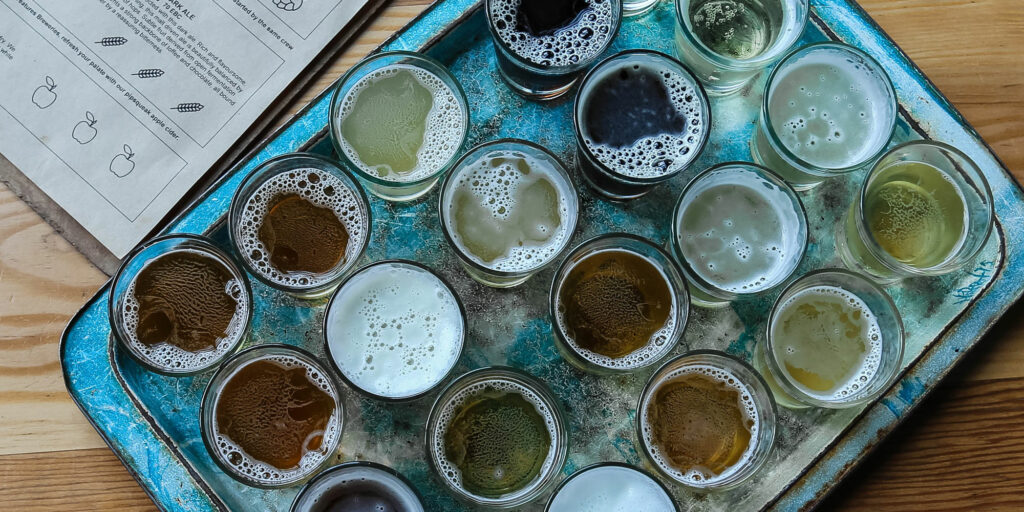Matthew Curtis looks into ways to make beer sustainable and how we can enjoy our favourite beverage for generations to come.

Making beer is a seriously resource intensive process. Every stage of beer’s supply chain, from farming, to distribution and logistics, and of course brewing itself—which is essentially a process of repeatedly heating stuff up and cooling it down—puts an immense amount of strain on the environment.
The impact of climate change on the brewing industry is already being witnessed in real-time. Both North American and German hop suppliers reported that several varieties have seen their harvest impacted by raised temperatures during the summer of 2023. Legacy US hop varieties such as Centennial, and coveted European noble hops such as Hallertauer Tradition have seen a decline in yields in recent years due to increasingly unpredictable temperatures and rainfall.
Extreme weather events are also on the rise. In a report from 2020, farmers in New Zealand’s Motueka region reported losing as much as half their crop due to a freak hailstorm. This would have had a knock on effect, leading many brewers who had contracted for coveted New Zealand varieties got little to nothing at all. It is thought that many of the world’s largest brewers including AB InBev, Carlsberg and Heineken are already planning for futures where hop, barley and wheat yields become increasingly unstable.
It’s unsurprising, then, that an increasing number of breweries are invested in—or at least want the appearance of being invested in—sustainable brewing and business practices. Although there are some individuals who try, it is foolish to deny the impact that climate change is having on our environment, and our lives. Consumers are also becoming more aware of their own carbon footprint, with those able to do so choosing to spend their hard earned cash on products with green credentials, and this includes their beer.
In reality, it’s almost impossible for a modern brewery to run sustainably—at least completely so. In the Conservative government’s Energy Bill Discount scheme published in January 2023, breweries were officially classified as ‘energy intensive businesses’. This particular piece of legislation was designed to recognise which companies needed more support due to the surging price of energy bills. However, it’s hard to deny how much energy is required to power a brewery, and why so many breweries are keen to force the point that they are looking at ways to produce their beer more sustainably
There is, however, also a risk of businesses doing something called ‘greenwashing’—embellishing their efforts to go green in order to give the impression that they are sustainable, when in reality they are not. In addition to running vast boilers to power huge kettles, and racks of glycol-chilled tank farms, breweries are reliant on industrial agriculture on a massive scale. Logistics, and the use of aluminium and glass (both of which require vast amounts of energy to produce, recycle, and ship) and the fact that beer needs to be kept cold, (which adds to that energy bill,) mean that claims such as—say—carbon offsetting through planting a forest, should be taken with a hefty pinch of salt.
It will take years for breweries to become truly sustainable, but the good news is that it’s possible. The largest barrier to this is money; making beer in an environmentally responsible way will require a decent amount of short to medium-term investment before we see genuine long term results. Despite this barrier, we are seeing breweries, both large and small, beginning to invest in equipment and processes that are genuinely shrinking their carbon footprint. With enough investment—not to mention plenty of positive intent—beer production can be sustainable. Here’s a few ways this is happening…
Renewable Energy
It seems obvious, but switching to energy generated by renewable sources such as wind or solar will have a huge impact on a brewery’s carbon footprint. The UK still produces over 40% of its net annual electricity output using fossil fuels such as coal, oil and gas. The sooner we can shed our dependence on them, the better. The switch to electric vehicles also falls under this category, and hopefully one day breweries will have access to fleets of reliable and refrigerated electric vans.
Some breweries are taking this idea one step further by producing their own electricity. In the US, larger craft breweries such as Allagash in Portland, Maine, plus giants including AB InBev, are installing large fleets of solar panels on their properties, allowing them to power their breweries (in part, at least) with their own supply of electricity. Solar panels remain expensive to install, however, so pushing for the use of renewable power from the grid seems like a more sensible short-term solution for most.
Gas Recapture
Carbon dioxide is produced naturally during fermentation, so it would make sense that breweries simply captured and reused it, right? Well unfortunately it’s not so simple. In order to use CO2 in brewing—which is classed as food production—then the gas must be food safe. To achieve this any captured gas must be ‘scrubbed’ so that it doesn’t risk contaminating any beer it comes into contact with with nasty chemicals or pathogens.
Until recently the technology that allows this has only been available to larger breweries, but recent developments have seen the scale of the equipment downsized. The Ramsgate Brewery in Kent (better known as Gadd’s) was one of the first small British breweries to invest in the expensive technology in September 2022, with Bristol’s Wiper and True in hot pursuit a few months later. The recapture of gas means they are less reliant on manufactured food-grade CO2 (which itself is a ghastly byproduct of ammonia fertiliser production). At present, these breweries still need to supplement their own product with bought-in gas, but Wiper and True’s founder Michael Wiper has reassured me that they’re on the path to producing 100% of their own Carbon Dioxide in house. As more breweries decide to invest in this technology, our reliance on fertiliser-produced CO2 will thankfully decrease.
Carbon Dioxide isn’t the only gas that breweries are able to capture and reuse. Nitrogen and Methane are also byproducts of brewing (with the latter typically only coming into play when a brewery reaches a very large size.) Like CO2 Nitrogen can be reused in the process of cleaning and purging brewing equipment. Methane can be recaptured and used to generate electricity—although this does require burning it like a fossil fuel. At New Belgium Brewing in Fort Collins, Colorado, you’ll see two large, white, balloon-like structures which do just that. In fact using a combination of this and solar panels on its roof, it produces a remarkable 25% of its own electricity.

Saving Water
Water usage, and who gets to use it, will arguably be the biggest conversation within beer and sustainability in the years to come. It takes a lot of water to make beer, around five pints for every single pint of beer unless your using a recapture system like available from Brewiks, in fact. Most of this isn’t actually used to make beer, but for cleaning. Ask any brewer and they’ll tell you that 90% of brewing is cleaning, and breweries investing in decreasing their water usage plays a huge role in the path towards true sustainability. Investment in the efficiency of processes, and the training of staff, is key to achieving this.
Responsible use of water also factors in. Brewing produces a lot of wastewater, sometimes referred to as effluent, which is unsafe for human consumption and must be properly cleaned before it is returned to the water supply. A handful of breweries, such as Purity in Warwickshire, and Geipel Brewing in North Wales, have constructed what’s known as a ‘reed bed system’. This network of ponds gradually filters water until it’s safe to return to the mains supply. The best part about this is that it’s very environmentally sound. The worst is that breweries housed in railway arches and warehouses across our cities simply don’t have the space to do it, as it requires a large amount of land usage in order to be effective.
Regenerative Agriculture
Industrial farming is, arguably, the largest contributor towards beer’s vast carbon footprint. Without crops such as hops, barley, wheat, rye, oats and more, there would be no beer, and to produce these consumables at the scale the brewing industry commands puts an immense burden on the land. In fact, the mere process of ploughing fields repeatedly releases large amounts once locked-away carbon back into the atmosphere.
Responsible farming comes in many shapes and sizes (and is part of a wider conversation concerning what we eat) but we are seeing more farms, and even some breweries, investing in regenerative agriculture. One example is Long Man Brewery in East Sussex, which uses regenerative farming techniques to produce its own barley sustainably, and help lock carbon back into the soil where it belongs.
Beer makers can also reduce their carbon footprint by only using ingredients farmed locally to the brewery. But with the reality being that most hops are farmed in Europe and the USA, with just 0.7% being farmed in the UK, that’s a particularly steep challenge for Britain’s 1900-or-so breweries. Reusing hops in a second brew is another potential option, one that was explored by Gipsy Hill in their Regenerator Pale Ale. The beer also used regeneratively farmed barley, which meant that it was technically carbon negative. This could well be the shape of beer to come if brewing is genuinely to become more sustainable.
Draught Beer
It might not seem as obvious as some of the methods above, but if we want beer to be more climate friendly, we need to get down to the pub. The glass and aluminium packaging industries use an immense amount of energy. Add the fact that you need a lot of space and energy to ship the empty packaging to breweries, then to fill it, and then to distribute it, then using a larger container to store beer suddenly makes a lot of sense.
Vessels like casks and kegs are infinitely reusable, and only need cleaning, not recycling, before they’re ready to be filled with beer again. Being a lot bigger than cans or bottles also means that it takes less energy from the brewery to get them filled. Put simply, if you want to make sure that your own beer-consumption carbon footprint remains pint-sized, you’re better off sticking to them over cans on the sofa at home.
Investing in People
This last part should go without saying, but if the beer industry really wants to be considered as sustainable it needs to invest in its people. I don’t mean getting the team together for a few pizzas at the end of the month either. I’m talking proper training and education, the implementation of high-level skills, a genuine career-ladder to climb and the wages to match. If beer is really going to be a leader in the climate change discussion, then it needs to become a people-first industry. A well-trained, well-paid workforce that’s invested in what they do will create the work forces that lead the brewing industry into a climate-positive future. And that’s a fact.
Matthew Curtis